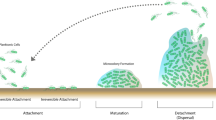Abstract
Planktonic bacteria passing to a sessile state during the formation of a biofilm undergo many gene expression and phenotypic changes. These transformations require a significant time to establish. Inversely, cells extracted from a biofilm should also require a significant time before acquiring the same physiological characteristics as planktonic cells. Relatively few studies have addressed the kinetics of this inverse transformation process. We tested one aspect, namely, the contamination potential of freshly extracted Escherichia coli biofilm cells, precultured in a synthetic medium, in a rich liquid growth medium. We compared the time between inoculation and the beginning of the growth phase of freshly extracted biofilm cells, and suspended exponential and suspended stationary phase cells precultured in the same synthetic medium. Unexpectedly, the lag time for the extracted biofilm cells was the same as the lag time of the suspended exponential phase cells and significantly less than the lag time of the suspended stationary phase cells. The lag times were determined by an impedance technique. Cells extracted from biofilms, i.e., biofilms formed in canalizations and broken up by hydrodynamic forces, are an important source of contamination. Our work shows, in the case of E. coli, the high potential of freshly extracted biofilm cells to reinfect a new medium.

Similar content being viewed by others
References
Baillie, GS, Douglas, LJ (1998) Effect of growth rate on resistance of Candida Albicans biofilms to antifungal agents. Antimicrob Agents Chemother 42: 1900–1905
Beloin, C, Valle, J, Latour-Lambert, P, Faure, P, Kzreminski, M, Balestrino, D, Haagensen, JAJ, Molin, S, Prensier, G, Arbeille, B, Ghigo, JM (2004) Global impact of mature biofilm lifestyle on Escherichia coli K-12 gene expression. Mol Microbiol 51: 659–674
Brooun, A, Liu, S, Lewis, K (2000) A dose response study of antibiotic resistance in Pseudomonas aeruginosa biofilms. Antimicrob Agents Chemother 44: 640–646
Costerton, JW, Lewandowski, Z, Caldwell, DE, Lappin-Scott, HM (1995) Microbial biofilms. Annu Rev Microbiol 49: 711–745
Davies, D (2003) Understanding biofilm resistance to antibacterial agents. Nat Rev Drug Discov 2: 114–122
De Beer, D, Stoodley, P, Roe, F, Lewandowski, Z (1994) Effects of biofilm structure on oxygen distribution and mass transport. Biotechnol Bioeng 43: 1131–1138
Gilbert, P, Collier, PJ, Brown, MR (1990) Influence of growth rate on susceptibility to antimicrobial agents: biofilms, cell cycle, dormancy and stringent response. Antimicrob Agents Chemother 34: 1865–1868
Kaplan, JB, Meyenhofer, MF, Fine, DH (2003) Biofilm growth and detachment of Actinobacillus actinomycetemcomitans. J Bacteriol 185: 1399–1405
McLeod, BR, Fortun, S, Costerton, JW, Stewart, PS (1996) Enhanced bacterial biofilm control using electromagnetic fields in combination with antibiotics. Methods Enzymol 310: 656–670
Rice, AR, Hamilton, MA, Camper, AK (2000) Apparent surface associated lag time in growth of primary biofilm cells. Microb Ecol 40: 8–15
Rice, AR, Hamilton, MA, Camper, AK (2003) Movement, replication, and emigration rates of individual bacteria in a biofilm. Microb Ecol 45: 163–172
Shigata, MG, Komatsuzawa, M, Sugai, M, Suginaka, H, Usui, T (1997) Effect of the growth rate of Pseudomonas aeruginosa biofilms on the susceptibility to antimicrobial agents. Chemotherapy 43: 137–141
Siegel, S, Castellan, NJ (1988) Nonparametric Statistics for the Behavioural Sciences, 2nd ed. McGraw-Hill, New York
Silley, P, Mortimer, F (2003) Rapid Microbiological Technologies in the Pharmaceutical Industry. Ed. M.C. Easter, Interpharm/CRC, New York
Sternberg, C, Christensen, BB, Johansen, T, Nielsen, AT, Andersen, JB, Giskov, M, Molin, S (1999) Distribution of bacterial growth activity in flow chamber biofilms. Appl Environ Microbiol 65: 4108–4117
Stoodley, P, Wilson, S, Hall-Stoodley, L, Boyle, JD, Lappin-Scott, H, Costerton, JW (2001) Growth and detachment of cell clusters from mature mixed species biofilms. Appl Environ Microbiol 67: 5608–5613
Tanaka, G (1999) Effect of the growth rate of Pseudomonas aeruginosa biofilms on the susceptibility to antimicrobial agents: beta-lactams and fluoroquinolones. Chemotherapy 45: 28–36
Telgmann, U, Horn, H, Morgenroth, E (2004) Influence of growth history on sloughing and erosion from biofilms. Water Res 38: 3671–3684
Van Houdt, R, Michiels, CW (2005) Role of bacterial cell surface structures in Escherichia coli biofilm formation. Res Microbiol 156: 626–633
Acknowledgments
W.J. Ellison and J.M. Moreau would like to thank Pr. A. Deschamps, Director of USMA, for permission to use his laboratory facilities. The authors are grateful to the European ERASMUS program, which encourages the mobility of young research workers.
Author information
Authors and Affiliations
Corresponding author
Rights and permissions
About this article
Cite this article
Caubet, R., Pedarros-Caubet, F., Quataert, Y. et al. Assessing the Contamination Potential of Freshly Extracted Escherichia coli Biofilm Cells by Impedancemetry. Microb Ecol 52, 239–243 (2006). https://doi.org/10.1007/s00248-006-9118-9
Received:
Accepted:
Published:
Issue Date:
DOI: https://doi.org/10.1007/s00248-006-9118-9




